Many watch enthusiasts are already familiar with Habring2, founded in 2004 by husband-and-wife duo Maria and Richard Habring in Völkermarkt, Austria. This team has been making small numbers of innovative watches marked by clean styling, including bespoke timepieces for discerning clients and mechanical creations for other brands.
In 2014, ten years after founding the workshop, Habring2 introduced its first made-in-Austria, in-house watch: Felix. This freshly designed, easy-to-wear timepiece won the Petite Aiguille prize at the 2015 Grand Prix d’Horlogerie de Genève.
Felix’s movement was the first to ever be developed and assembled in Austria (right at the Habring2 workshop), and its case was manufactured using Austrian steel from the Böhler smeltery in Kapfenberg.
Since then, the Felix line has steadily grown to include a full collection of interesting complications like the Foudroyante-Felix, a split-seconds chronograph, and the monopusher chronograph Chrono-Felix.

Habring2 Chrono-Felix Panda
Today, I’d like to take a look at 2020’s Chrono-Felix Panda, the latest iteration of the Felix family’s chronograph.
Habring2 Chrono-Felix Panda: design
Let’s start with the design of the Chrono-Felix Panda as that’s what you see first. The dial is the “face” of any watch, and the “look” usually plays a large (if not the largest) role in a consumer’s choice of whether or not to buy.
The Chrono-Felix Panda’s symmetrical design, entirely crafted by Maria and Richard Habring, continues in the classic vein of the Felix collection, which is slightly more Bauhaus than the timepieces the duo made before Felix. But it remains fully consistent with the small company’s utilitarian philosophy and is as clear and clean as a wristwatch comes.
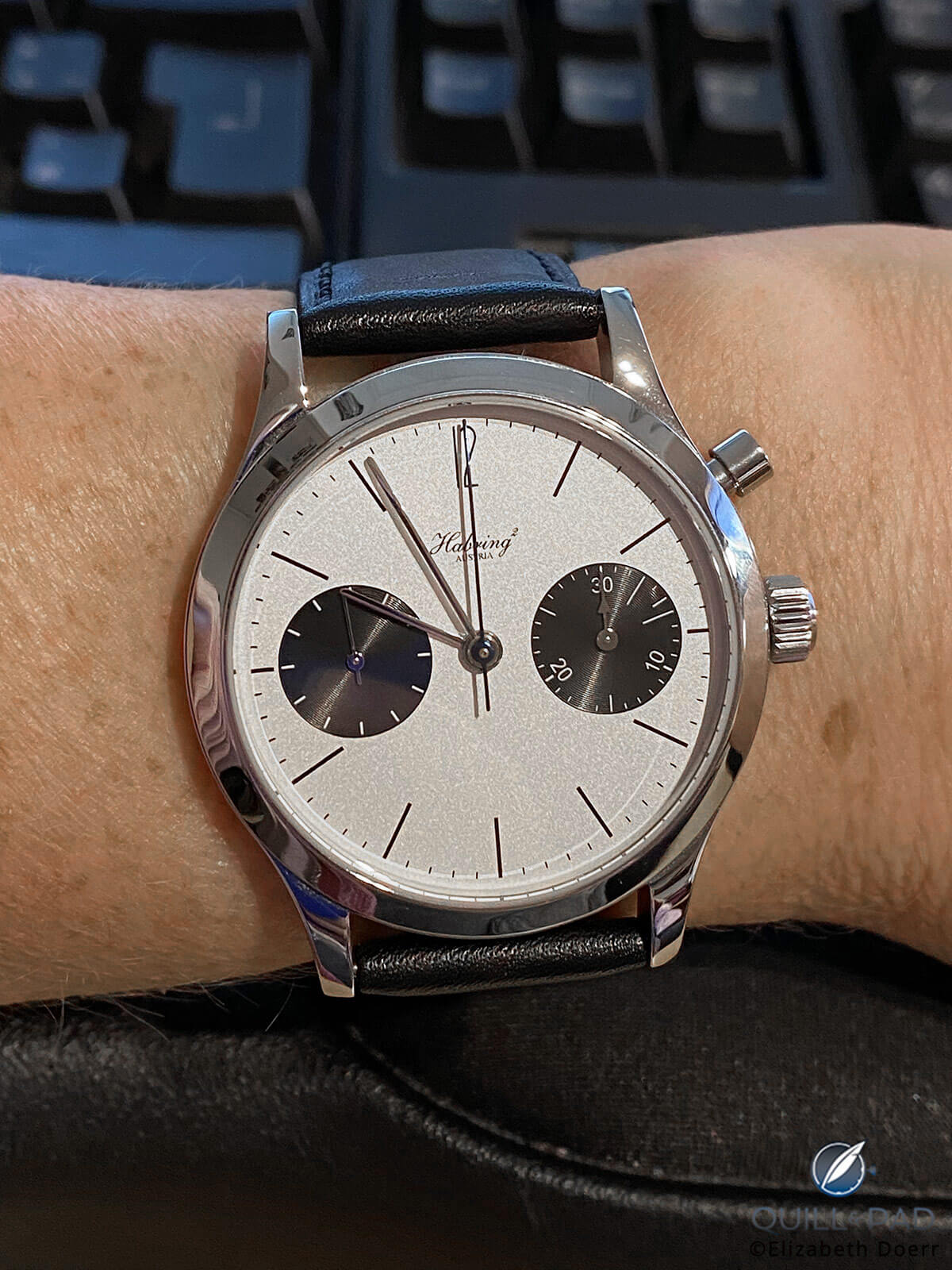
Habring2 Chrono-Felix Panda on the wrist
The design is very classic in the understated way that Germanic timepieces are famous for. I appreciate the no-nonsense approach and reserved presence of the Habring2 timepieces – and Germanic watches in general – so I find the design very pleasing.
Watch aficionados may know that the “panda” moniker originates in the look of the two black subdials set against the stark white of the dial, forming what to all the world looks like a panda face. The “white” dial in this case is not just white, but a very attractive, ever-so-light, glittery, silvery-white that in the right light mimics the look of grainage.
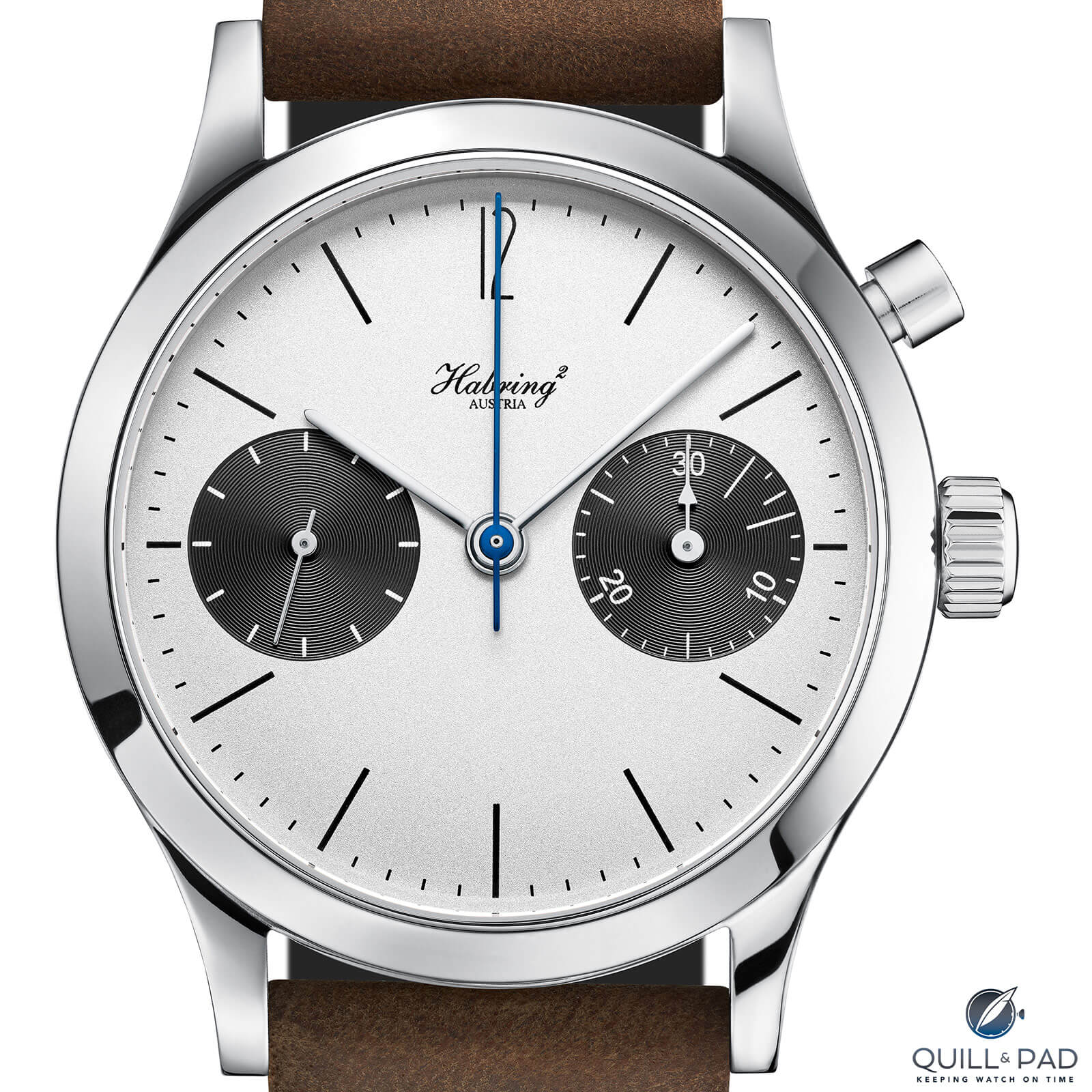
Habring2 Chrono-Felix Panda
A nice detail – albeit one that is all but impossible to see with middle-aged eyes – is the arrowhead minute counter hand in the minute totalizer subdial. That hand is much easier to see on the other versions of the Chrono-Felix as the backgrounds are not black.
And while Chrono-Felix’s styling is similar to other members of the Habring2 Felix family, the bicompax arrangement of the black subdials together with the stark look of the shiny steel hands against the silvery dial background make this one very attractive watch.
At only 38.5 mm in diameter and 10.5 mm in height, this Austrian monopusher chronograph remains almost as svelte as the time-only Felix. And the absence of a customary second pusher for the chronograph’s reset function makes the watch look lighter than a two-pusher chronograph.
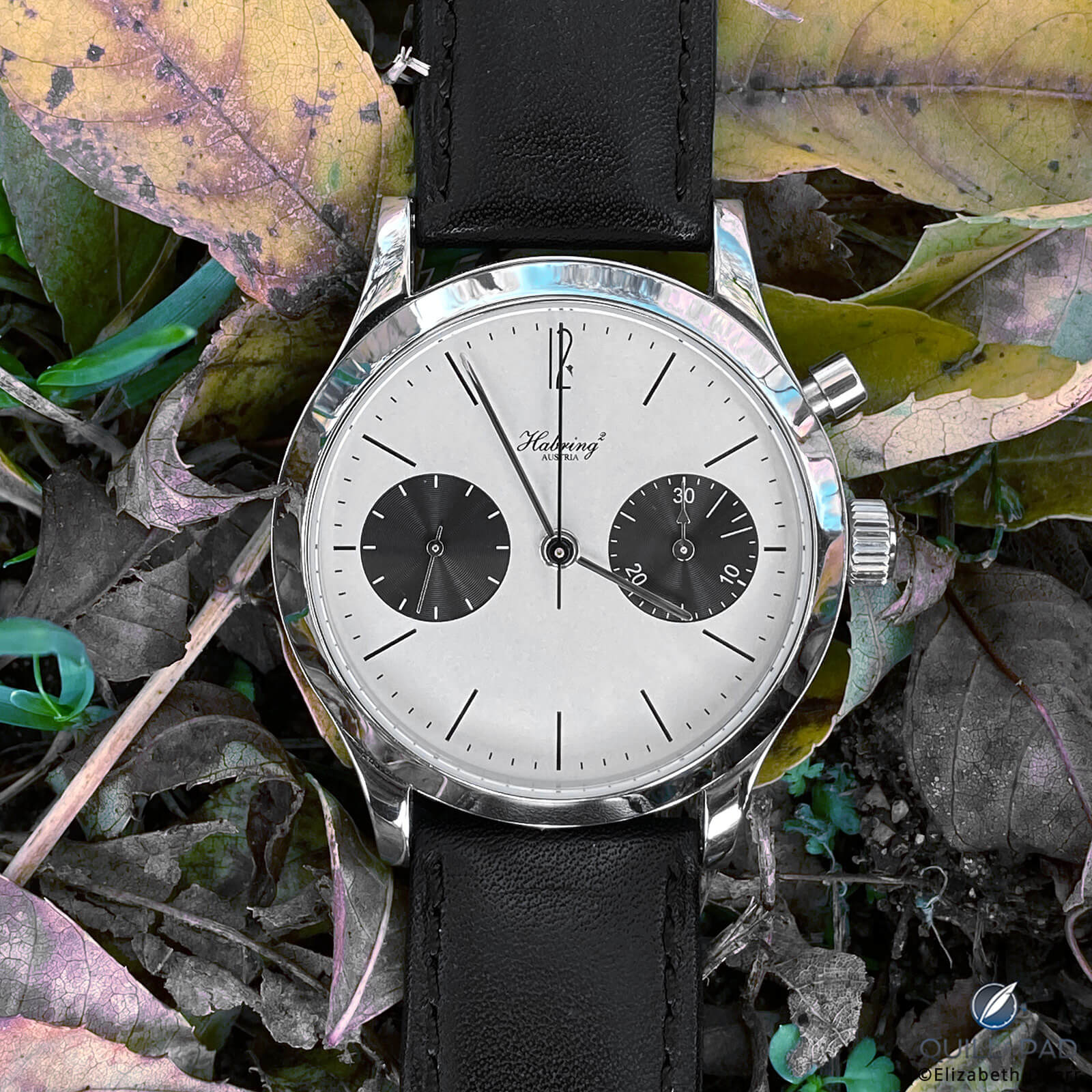
Habring2 Chrono-Felix Panda
Habring2 Chrono-Felix Panda: Caliber A11C-H1
The advent of in-house Caliber A11 – the base of A11C-H1 – was a more than appropriate way to celebrate the milestone tenth anniversary of Habring2 in 2014. This is the first watch movement ever made in Austria.
Designed to be Habring2’s new base for future developments, the Caliber A11 movement was developed so that new functions could be added.
Habring2’s long history in chronographs predates the brand’s now 16-year existence. Richard Habring was one of the head technical minds at IWC and inventor of that brand’s 1991 split-seconds chronograph (“double chronograph”), which was based on the ETA Valjoux 7750, the world’s most popular mechanical chronograph movement.
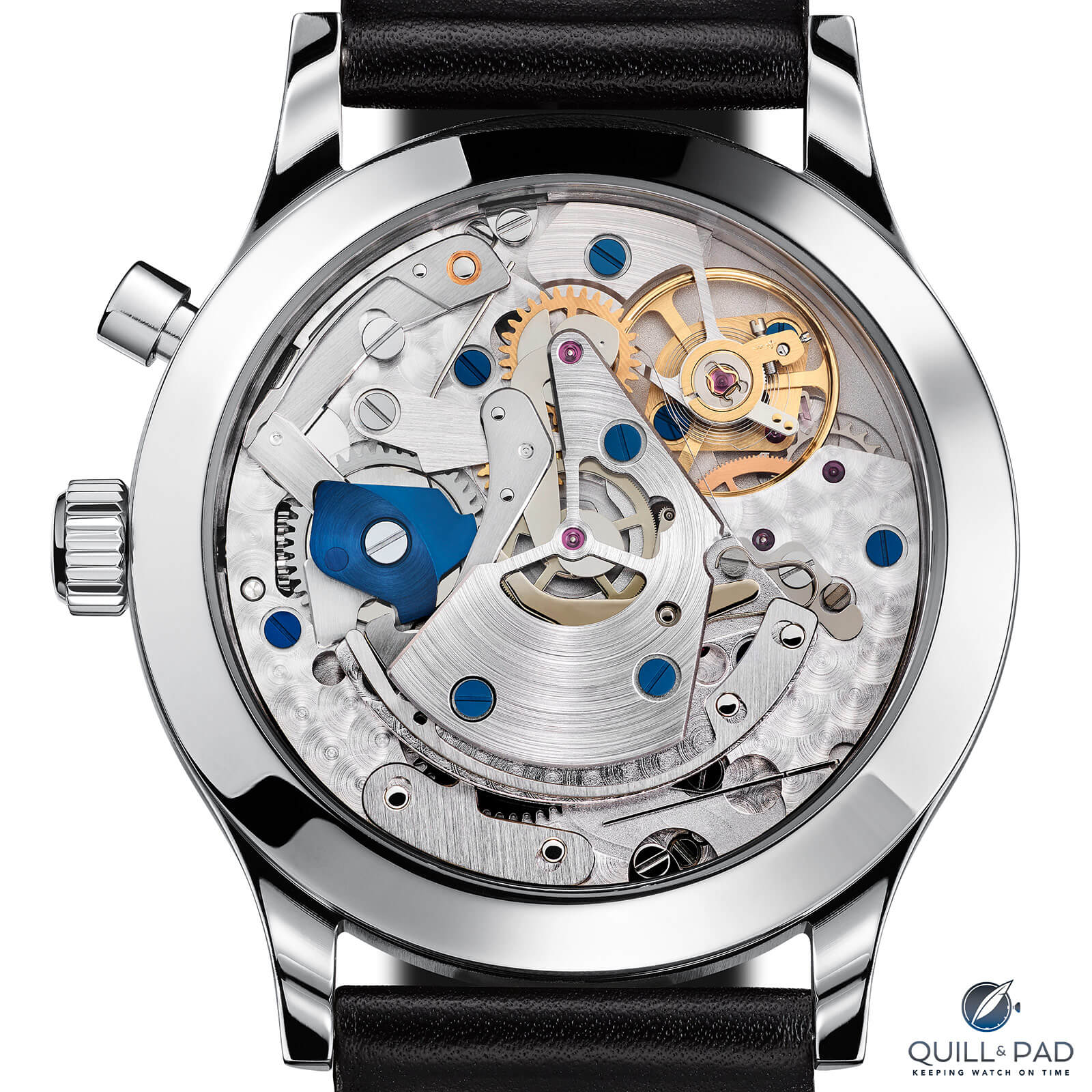
Habring2 Chrono-Felix Panda from the back
Habring has long admired the 7750, and Caliber A11C-H1 shares some similar characteristics to the 7750, but also much that is different and improved. Looking at Caliber A11C-H1 through the sapphire crystal case back, most would not discern its 7750 conceptual provenance. And it is important to note that the 180 components making up this caliber were produced by independent suppliers according to Habring2’s specifications, all of whom are located in Austria, Germany, or Switzerland. No corners were cut in the making of this movement.
The chronograph is controlled by a cam that has been tempered blue so it is easily recognizable through the sapphire crystal case back. As the only tempered component in the entire movement aside from a few of the screws, it is quite hard to miss the cam against the monochrome backdrop of the rest of the movement with its clean, utilitarian, handcrafted finish. With the exception of perlage on the plates, the absence of ultra-fancy finishing techniques helps keep the Chrono-Felix Panda relatively affordable.
The Habring2 chronograph module, which sits atop the A11 base movement, is low in height, which goes a long way toward keeping the movement slim at 6.5 mm. And that is reflected in the watch’s overall elegant height.
The action of the chronograph button is crisp, the cam jumping to immediately upon receiving the order – a tangible delight. This could be the result of the very precise laser-cutting process used to manufacture the components as opposed to the stamped components that large-volume movements like the 7750 adhere to.
And it is very important to the Habrings that their in-house movement is easy to service and repair, which goes for the boutique brand’s older ETA-based models, too. This is why so many of the A11’s components are compatible with the 7750 movement. The similarity also means that any watchmaker will be able to repair or service these watches now or in the future. That’s a gigantic plus demonstrating respect for the brand’s clients.
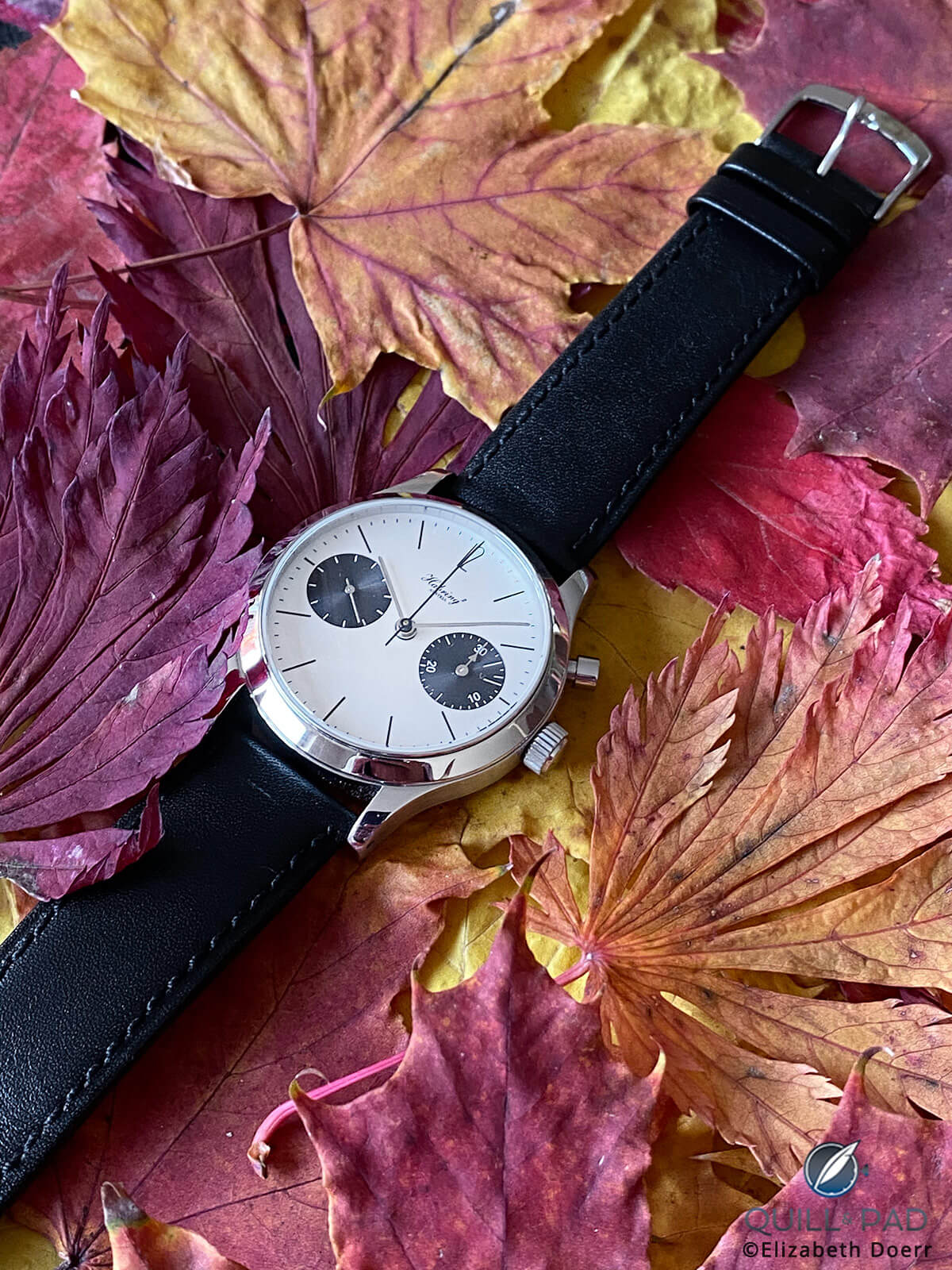
Habring2 Chrono-Felix Panda
What I love – and don’t love – about the Habring2 Chrono-Felix Panda
When I opened the box, my breath caught for a moment: I was pleasantly surprised by the gorgeous design as it appeared to stare up at me with panda-bear eyes from inside its travel packaging.
The next big surprise for me was the watch’s substantial feel; I couldn’t help but immediately strap it to my wrist and parade through the building snapping wristshots. The fit is perfect even on my small wrist – the 38.5 mm sizing is my sweet spot – which is astonishing given the really solid feel of the watch.
The lithe sizing is perfect for any wrist, male or female. Like other Germanic brands – notably Nomos Glashütte – the unisex ideal is alive and well at Habring2, which I very much appreciate. The case is slim, svelte, and comfortable.
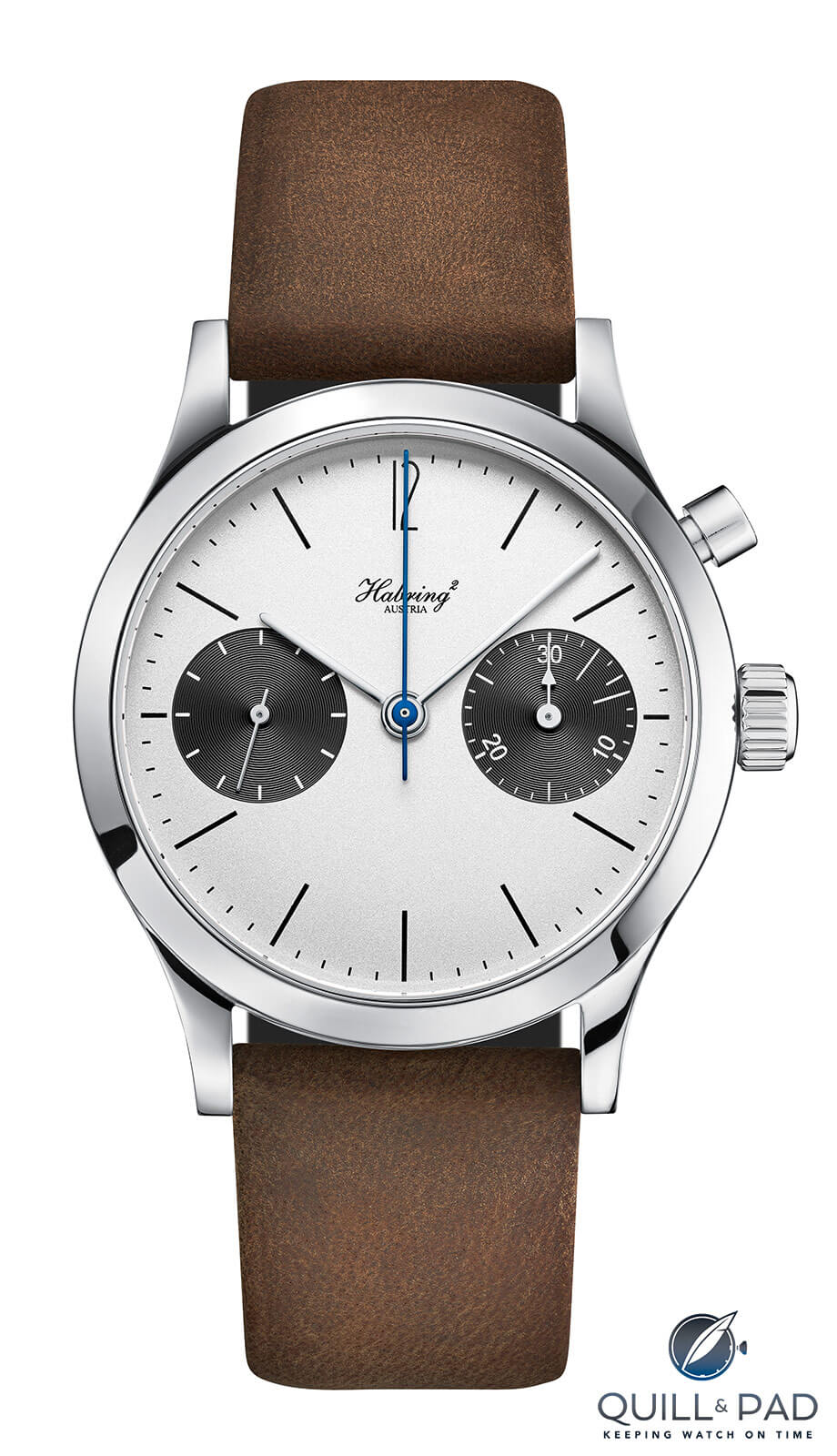
Habring2 Chrono-Felix Panda
The monopusher chronograph button and panda styling lend this watch a beautiful vintage feel that vibes just right for me, though this watch is decidedly modern in every way. The styling adds the right pinch of everything to this technical charmer.
Also, I have to praise Habring2 for once again adding hacking seconds. Even though it’s a relatively simple thing for watchmakers to add to any watch, hacking seconds is never a given. I love that Habring2 thinks about its clientele’s desire for precision by including seconds that stop when the crown is pulled out on its watches, allowing for precise to-the-second setting.
But what is bound to make anyone enthusiastic about this watch is its incredibly fair price. When you consider all that this watch offers – in-house manufacture movement, low production numbers by a boutique collector’s brand, and refined styling – the price hardly seems fair to the manufacturer. But affordability has been part of the Habring2 concept from day one.
As GaryG loves to say, however, no watch is perfect – though a given watch may be perfect for you (or me).
That said, I have one small quibble, but it one that would not prevent me from buying it if I were in the market for a chronograph.
Shiny, high-polished, sliver-thin steel hands are hard to read on any watch as they tend to get get lost in everything else happening on the dial. And here, with the blued-steel chronograph hand and the black totalizers, it is not always easy to immediately discern which hand is which when looking for the time.

Habring2 Chrono-Felix Panda
I imagine, though, that if I owned this watch, I would get used to it over time. My eye would likely learn to disregard the chrono hand when it’s not in use.
The Chrono-Felix Panda is also available with all blued-steel hands, but I think that they might add to any confusion rather than alleviate it, even though I normally find blued steel hands much more attractive in general.
In case you’re not enamored of the stark black-and-white styling of this watch, do note it is also available in three other variations: a silvery-white dial with white totalizers and either black printing or black with a red 12, or a salmon-colored dial. Each of the variations are striking, though I am partial to this new pet panda.
For more information please visit www.habring2.com/index.php/en/collection/chrono-felix.
Quick Facts Habring² Chrono-Felix
Case: 38.5 x 10.5 mm, Austrian stainless steel
Movement: manually wound Habring Caliber A11C-H1, 4 Hz/28,800 vph frequency, 48-hour power reserve, Carl Haas balance spring in chronometer quality
Functions: hours, minutes, (hacking) small seconds; monopusher chronograph with 30-minute counter
Price: €6,250 / 5,650 Swiss francs / £5,600
You may also enjoy:
In Praise Of Habring2: A Collector’s View
Habring2 Gets Happy (And Serious) With Felix, Featuring First Austrian Movement
Leave a Reply
Want to join the discussion?Feel free to contribute!





















































That bezel looks like it was specially designed to attract ugly scratches the moment you put it on your wrist! except for that glaring problem, very nice.
Getting one of these soon, your pictures really helped me decide.
That’s amazing to hear, Gav! You may be very unsurprised to hear I decided to get one too after spending time with it….
Excellent! Currently deciding what strap to have with it as they offer quite an extensive choice. The light sand-coloured one is tempting me, but not sure.
Did you get the panda, the silver, or salmon dial by the way?
The panda! I guess I fell in love with it.